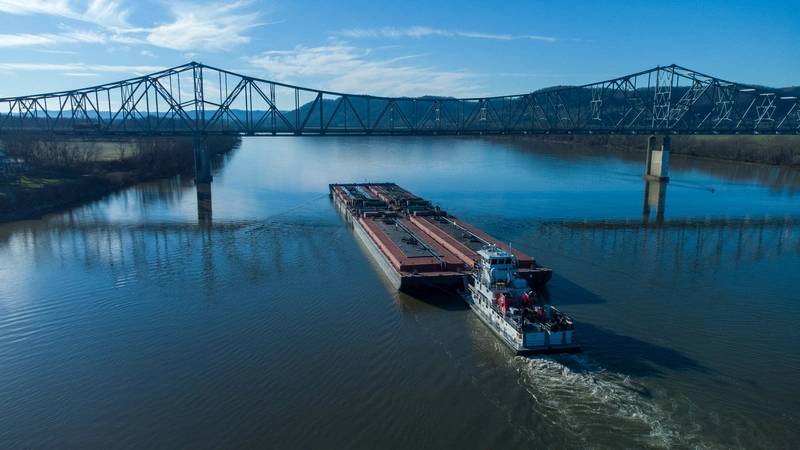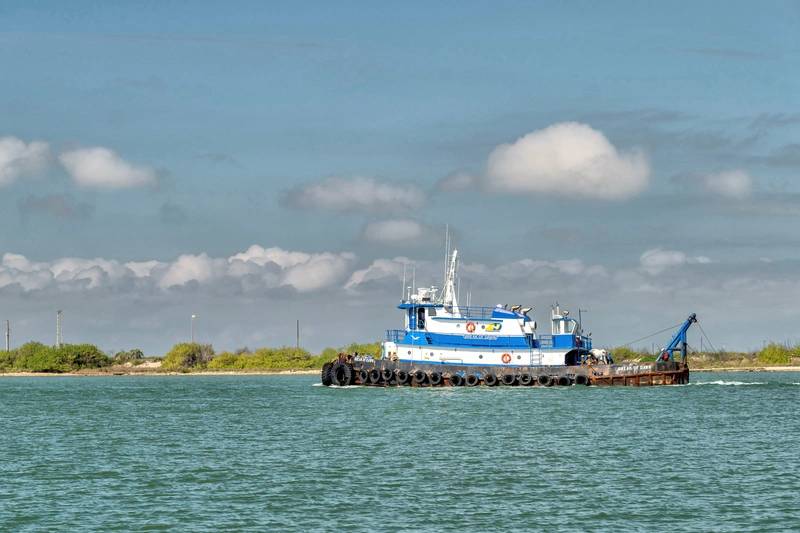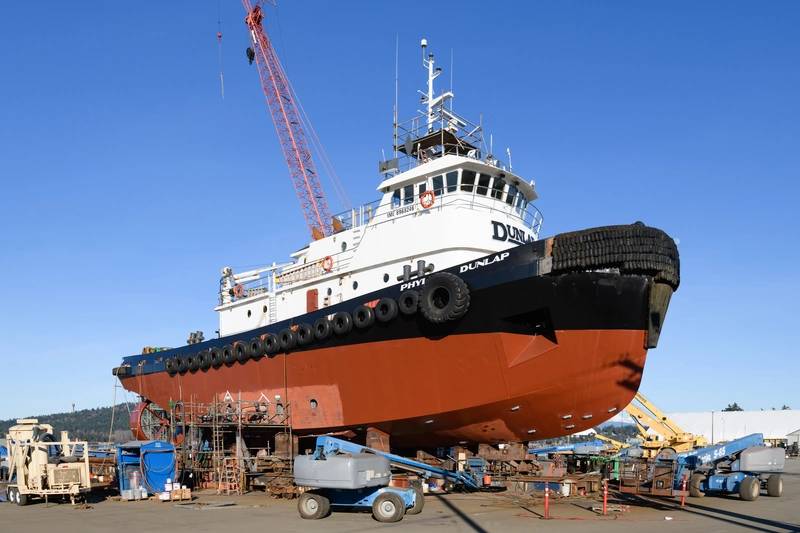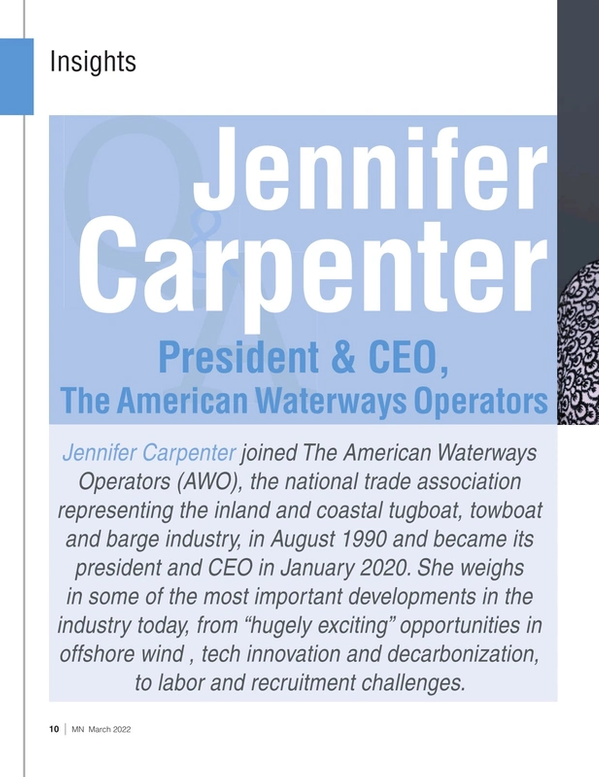
Interview: Jennifer Carpenter, President & CEO, AWO
Jennifer Carpenter joined The American Waterways Operators (AWO), the national trade association representing the inland and coastal tugboat, towboat and barge industry, in August 1990 and became its president and CEO in January 2020. She weighs in some of the most important developments in the industry today, from “hugely exciting” opportunities in offshore wind , tech innovation and decarbonization, to labor and recruitment challenges.
The recent Infrastructure bill is a huge boost for many industries, especially inland waterways shipping which so desperately needs funding to help chip away at a long list of infrastructure projects. Please describe the impact the bill and these improvement and repair projects will have for the barging industry, as well as next steps to ensure benefits are maximized.
Phrases like historic investments can sound trite, but in this case, the description is really apt. This infusion of funding into our ports and waterways infrastructure and specifically our inland waterways infrastructure is really the biggest since the New Deal. As an advocate for the barge industry, obviously I care a lot about the safety benefits to our industry, and the people who work in it, and the efficiency and reliability benefits for our member companies who move cargo on the water. There are big benefits to shippers who rely on barge transportation. There are going to be many more jobs for the skilled workers who are going to do the building and construction and repair of these locks. And all of that is true and all of that is big.
But as I've had a chance to reflect on this over the last few weeks, what's really striking me is bigger picture. This is really an investment in U.S. economic competitiveness and our environment. A new National Waterways Foundation Texas Transportation Institute study reaffirms that barges are the safest, and the most efficient, and have lowest carbon footprint among competing modes of transportation. The statistic I love; large transportation produces 43% less greenhouse gas emissions than rail, 832% less than trucks to move the same amount of cargo. So, I look at this investment in our waterways infrastructure, and I say that investment is going to help us to realize all of those environmental benefits. It's just huge. It's good for the barge industry. It's good for shippers. It's good for carpenters and pipe fitters and skilled labor who we're going to be working on them, but it's really good for our country, economically and environmentally.
Now, what do we need to do to really make it all happen? I think the Corp of Engineers did a great job in the work plan that they released recently. So, follow the capital investment strategy, which is really prioritized plan for allocating this funding that was jointly developed by the Corp and the Inland Waterways Users board. They're doing that. That's great. Keep doing that and then get that Inland Waterways Users Board up and running again so that it is available to consult with the Corp as monies are spent. This is a federal advisory committee that's been around for some time. It was temporarily paused last year when the new administration came in and took a look at all of its advisory committee. That's a common thing that new administrations do. It's been reconstituted, but that group needs to get and get meeting because there's important work to be done and to be collaborating on.
 © Drew / Adobe Stock
© Drew / Adobe Stock
The U.S. Coast Guard recently announced it is proposing to revise user fees for inspected towing vessels. What’s AWO’s view on this, and what changes would it like to see (if any)?
We were just talking about infrastructure. Everybody loves infrastructure; everybody hates user fees, for good reason. So just quick background. People don't always remember that or realize that user fees for certain Coast Guard services have been required by statutes since 1990 to offset the federal budget deficit. They don't provide any direct benefit to industry or to the Coast Guard. The Coast Guard does not get this money.
So, as we look at this rule, the Coast Guard didn't just decide to do this. They are required to assess user fees. But they have the authority, under law, to consider factors, including the public interest, in deciding what fees to charge. We're going to be convening our members to do a deeper dive into their proposed rule. But what I would say at this point is we would like to see fees slashed for TSMS vessels and frozen for Coast Guard option vessels. TSMS vessel owners pay tens of thousands of dollars in fees to Coast Guard approved third parties. They have been really overpaying Coast Guard inspection user fees since the user fee went into effect for some as early as 2020. They really deserve a timeout from fees. For Coast Guard vessels, we think, keep it the same for now. Don't triple it. Companies who are using both options, TSMS and Coast Guard, have invested millions of dollars in compliance costs to get ready for the hundred percent COI to deadline in July of this year. And we really think coming up, a pandemic and a recession and facing labor shortage and increased costs across the board, now is not the right time to increase fees that don't increase safety or benefit Coast Guard programs.
With regard to Subchapter M, how are things looking on that front? And do you expect that almost everybody will be ready on time?
I am feeling very bullish about AWO members being ready, being where they need to be, and getting to 100% fleet certification by July 19. We are increasingly seeing Subchapter M doing what it was intended to do, which was raise the bar of safety across the board. We've begun to see the retirement of some more marginal equipment. I think we're going to see more of that as we get closer to July 19. So that we really get to that date and it's like, "Hey, the vessels that are ready, the vast majority of vessels that are ready and meet the standards, off they go, and it's going to be a positive thing for industry safety."
Those vessels that just can't get there, they need to go, they need to be retired. They need to be taken out of service. And AWO members who are going to be ready on July 19 are expecting the Coast Guard to hold the whole industry accountable. The deadline is the deadline. It's been a long time coming. Everybody needs to be ready. And I think we're increasingly feeling good that the Coast Guard is serious about enforcing that deadline, which they need to be and which is only fair to the vast majority of operators who have worked really hard to get ready.
 © scandamerican / Adobe Stock
© scandamerican / Adobe Stock
Technology in areas like vessel autonomy and electrification is advancing ahead of regulations. What’s the solution to this problem, and how can the industry and regulators best strike a balance to ensure vessels remain safe without stifling innovation?
Great question. A few thoughts on that. One is to really recognize the safety and environmental benefit of innovation and lean into it. Sometimes you hear innovation technology and you think, "Oh, this is something to be balanced against safety." And I think there are certainly times when that's true. But I think it's important to recognize that technology has huge potential to make things safer for the industry, to give mariners and shore side employees new and better tools to do things safely. It's important that we first and foremost, make sure that the adoption of safety enhancing technology is not being discouraged with ill-fitting regulations. So for example, if a vessel owner is installing certified, automated equipment in the engine room, which by regulation should qualify it for a manning level, a crewing level that takes into account that automation, then we need to make sure that it really does and not, "Wow, I've made this enormous investment in safety enhancing technology and I'm being told that I have to crew this engine room in exactly the same way I would if I didn't have it." That is a discouragement to the adoption of technology.
Two would be, we need to make sure that the Coast Guard has the statutory authority and flexibility to establish appropriate standards. And if they don't, then they need to get it. They need to go to Congress and get it. And we, as an industry, will certainly support it. So that could take a form of seeking statutory authority to authorize certain pilot projects and report back to Congress within a certain period of time on the safety benefits or on safety needs. It doesn't need to be as complicated as, "Oh boy. We have to be stuck here until we can rewrite the whole code of federal regulations or the whole US code as it applies to certain subjects." No. There'll be time to go back and make strategic changes, but there's an opportunity to make sure that the Coast Guard has the broad authority to undertake pilot projects, for example.
Couple other things. Draw on the expertise of the private sector, like advisory committees, class societies, interagency and international partners. That worked really well with the Chemical Transportation Safety Advisory Committee and LNG, when the Coast Guard was trying to figure out, "Hey, what do we need to do to make sure that LNG-fueled vessels can operate safely or LNG bunker barges can be operated safely?" They worked with CTAC and they were able to really harness a lot of expertise in a pretty timely manner. Don't start from square one. Where there is technology that has been successfully used in Europe or other parts of the world, let's build on the work of others. What testing has been done on that? What experience is there on it? It hasn't happened here yet? Okay. But where has it been used up with that experience, and let's start from there rather than top dead center. And then finally, I would say regulatory certainty supports innovation and regulatory patchworks stifle it. And we saw that with ballast water, where investment owners were ready, they were willing to make enormous investments in ballast water treatment technology. And they were held back a bit because they didn't have assurance that that technology was going to be accessible in every state where that vessel might call. I hope that as we look at low and zero carbon technologies, other advanced technologies, we can learn from that experience and do better and make sure that yes, we've got appropriate safety standards in place and do that in a way that provides some uniformity and certainty, so that we don't have a situation where a company is willing to make a big bet, but just can't responsibly do that because they don't know if it's going to fly everywhere the vessel operates.
Earlier you discussed how barging is significantly cleaner overall compared to other transport options, but is there still room to clean up more and reduce emissions? And if so, what do you see as the avenues to do that right now?
Yeah, absolutely. The whole issue of decarbonization and environmental footprint is one where our industry has both the near and the long term opportunity to be a huge part of the solution. If a shipper wants to reduce the carbon footprint of their supply chain now, a great step for them to take is to commit to moving more by barge. And that's great. And I expect that to continue for the foreseeable future.
Our industry, like any industry that operates vessels that has engines, these are internal combustion engines. Are there opportunities to further drive down emissions and improve carbon footprint? There absolutely are. And we need to explore those and we need to embrace those, and we need to do that in a smart way. One thing AWO members have said is, "Look, we've got an operationally diverse industry." And what makes sense as a harbor tug that is able to potentially plug into shore power, is going to be a different solution than works for a towboat moving 40 loads down the Mississippi River, or a tugboat moving cargo between the west coast of the United States and Hawaii.” So, it’s important to set performance targets rather than trying to dictate the technology of the future or the fuel of the future. It's quite likely that there will be different technological approaches that will be better fit depending on a vessel's mode and area of operation. So, recognizing that and not trying to shoehorn into one approach.
And then also recognizing that it's really important not to strand economically viable assets. Vessels that are operating and producing revenue today, that revenue is what is going to be used to invest in lower carbon technologies in the future. We can't nickel and dime away current operations at the expense of future gains. We're dealing with a situation right now in California where the California Air Resources Board, CARB, has proposed requirements for harbor tugs, which will just do exactly that. Take a perfectly brand new, state-of-the-art, Tier 4 engine and say, "That's not good enough. You have to put a diesel particulate filter on that." Wait a minute. These kinds of incremental improvements to the diesel engine, while potentially helpful, could stand in the way of investment in really more powerful emission reduction technologies that could be implemented in the future. So that is, I think, a really important thing to keep in mind. We need to be able to pay for this. And that's not trying to get out of something. That's being reasonable and practical. A company, a vessel owner has to have some assurance that when they make an investment in a new technology, they're going to be able to recoup that over a period of time, otherwise they're not going to make the investment. They're the market, and that's not good.
The emerging U.S. offshore wind industry will rely on a fleet of vessels—new and old—to help build, commission, service and eventually decommission a raft of new projects slated to sprout up in the coming years. With momentum gaining and project approvals expected to accelerate, does the U.S. currently have the capacity to build and crew these vessels in a timely manner?
Yes, we can, and we need to get busy in a hurry because vessels take time to build. But I'm confident that we've got the shipyard capacity, we've got the expertise, we've got the know-how. We can do it. Sometimes people will ask, "Do we have all the vessels that we need now to produce 30 gigawatts of energy from offshore wind by 2030?” And I think that's the wrong question because this is a new industry that we're building in this country. We don't have vessels that have been sitting on the shelf waiting for something that didn't exist to come into fruition. We're building something new, and we've got to go create the supply chain that will support that. It's a hugely exciting opportunity, and I think the domestic maritime industry is well up to the task.
But the recent improvements to the permitting process, seeing projects actually get approved and come to fruition, that is huge in creating that regulatory certainty that we talked about in a previous question. Something else that creates certainty. Contracts, letters of intent. So, when a vessel owner knows there is a market for these new vessels, then they go forth and build. And I think in that regard, the statutory clarification that was enacted at the beginning of 2021, where Congress said US law, including the Jones Act, applies to offshore renewable energy, just as it does to oil and gas. That was really, really helpful in clarifying the ground rules and really paving the way for domestic maritime to step up to the task. Now we need Customs and Border Protection to be timely when it's given a request for a letter ruling. "Hey, how does this particular thing that I want to do comply or not comply with the Jones Act?" We need them to rule on that in a timely way, because that helps to create that certainty that will enable vessels to get built in the US.
What are the most important issues facing the tug, towing and barge industry today?
One of our biggest challenges right now is labor. Like pretty much every sector of the economy, we have a near-term challenge finding the workers that we need to keep up with increasing demand. We also have, really, the longer-term imperative. So, we've got to find our way through the current labor shortage, but we've also got to really work to create a future in which our industry is an employer of choice for a young man or a young woman who comes out of high school. They want to work hard. They want to be outdoors. They want to work with their hands. They don't want to be behind a desk. They don't want to live their life on a computer. Our industry has just tremendous opportunity that we can offer, economic opportunity, advancement opportunity, the opportunity to do really meaningful and relevant work, and we got to make sure that we are able to find and keep the pipeline of mariners that we need to continue to make the industry go.
The second big issue that I would highlight, we talked about it earlier, is surely environment and decarbonization. And as I said before, I think this is a huge opportunity for our industry. It's an immediate way for shippers to reduce the carbon footprint of their supply chain, because we really are a big part of the solution. But, as we discussed, there's also a challenge and we need to be smart and strategic as we work to drive the missions down further.
Is the industry doing enough to attract a diverse, skilled workforce?
We've got to do more. I don't think we can ever do enough. People make this industry go, and so casting a wider net and ensuring that our workplace is inclusive and welcoming to a wider net is crucial. And I think it's also, it's important not only to our industry, but also to our country. I mean, we need more US mariners to support our economic and homeland security. So we need to be able to find them, they need to know our industry exists, and they need to understand why it matters and what it can do for them in terms of a career in the future. And we need to make sure that we've got a workplace that is welcoming to them and where they want to stay, because there's a lot of opportunity.
 © Ian Dewar / Adobe Stock
© Ian Dewar / Adobe Stock
What are AWOs top goals for this year? And even beyond that. And what are your plans to achieve them?
I want to go beyond talking about discouraging Jones Act waivers, or modernizing regulations to make sure they keep up with technology, or making sure that the Coast Guard has a fleet of waterways commerce cutters to keep our rivers and navigation channels open for business. Those are all important things that we're going to be doing.
When you look at the bit bigger picture, what are we trying to do? We are here to be the industry's advocate resource united voice, and we want to make sure that we are proactively identifying and shaping, influencing issues at the federal level, at the state level, at the regional level, at the international level, that affect our members ability to succeed in a changing environment. We are here to help members deal with the stuff that is in front of us right now, like getting to 100% fleet certification on Subchapter M, making sure that the Corp of Engineers is not issuing permits for docs that are going to cause navigation safety problems and impact the ability of moving the U.S. harvest to market. But we're also here to really support our members in planning and preparing for those longer-term challenges.
We talked about decarbonization, we talked about ensuring the workforce of the future, and those are things where there are concrete actions we can take now and we are taking now. And it's also about working to make sure that we have what we need in the future, because the really hard stuff, you can't do it alone. You have to partner with coalitions, you have to get ahead of it, you have to stay united, and you can't start thinking about it or dealing with it when it's a crisis or when it's right in your face. You have to be preparing for it.
Read Interview: Jennifer Carpenter, President & CEO, AWO in Pdf, Flash or Html5 edition of March 2022 Marine News
Other stories from March 2022 issue
Content
- Interview: Jennifer Carpenter, President & CEO, AWO page: 10
- Infrastructure Funding Opportunities for Small Ports page: 18
- Recovery, Resilience and Demand Shifts to Drive Inland Waterway Cargo Flows page: 20
- Alt-fueled Workboats: Building the Business Case page: 26
- Current Direct: A Transition Effort in Europe page: 31
- 2022 US Shipbuilding Report page: 32
- Carboline: 'Bigger and Better' at 75 Years page: 37


